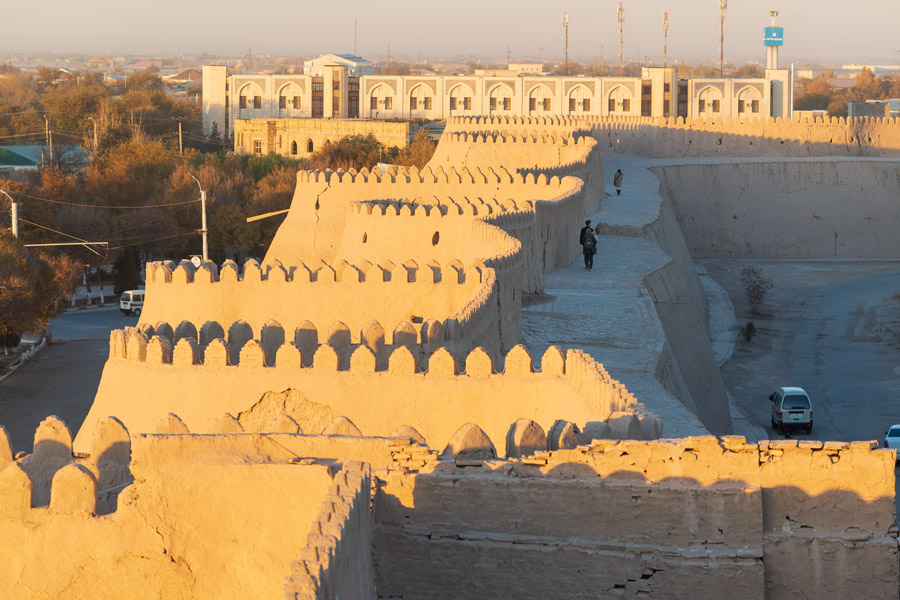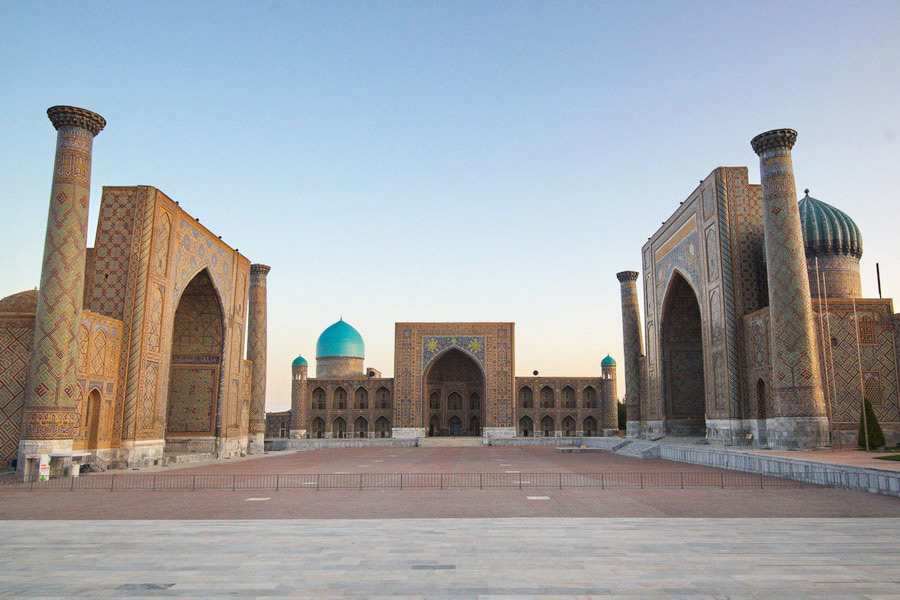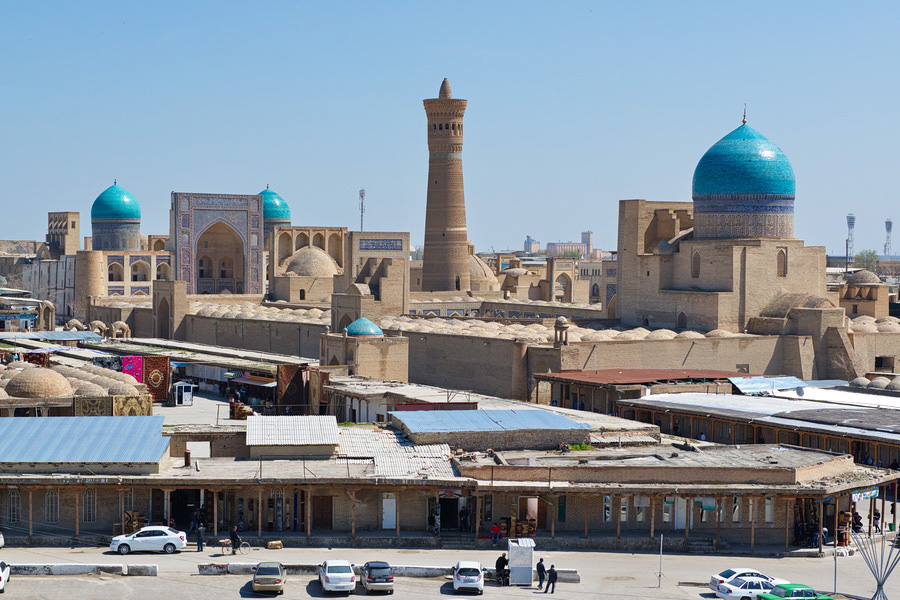
Uzbekistan and UNESCO
The rich history and culture of Uzbekistan are highly appreciated by the world community. The ancient fortress of Ichan-Kala, located in modern Khiva, was inscribed on the UNESCO World Heritage List in 1990.
Uzbekistan became a member of the United Nations Educational, Scientific, and Cultural Organization (UNESCO) in 1993.
In 2022, Uzbekistan became a member of the UNESCO Intergovernmental Committee for the Protection of Intangible Cultural Heritage. The membership will last until 2026.
World Heritage Sites in Uzbekistan

Today, the list of prominent places on the map of Uzbekistan includes seven objects from the UNESCO World Heritage List:
- Ichan-Kala fortress in Khiva (included in the UNESCO list in 1990),
- Historical center of the city of Bukhara (included in 1993),
- Historical center of Shakhrisabz (included in 2000),
- Samarkand - crossroads of cultures (included in 2001),
- Western Tien Shan (included in 2016),
- Turanian Deserts in the Temperate Region (included in 2023),
- Zarafshan-Karakum Corridor (since 2023).
Itchan-Kala
Itchan-Kala is the inner city of Khiva, which has a 2000-year history. The fortress of Ichan-Kala is one of the best monuments of Central Asian architecture. Famous buildings - Kunya-Ark, Kalta-Minor and Islam-Khoja minarets, Tash-Khauli Palace and Juma Mosque, attract many tourists.
Historical Center of the City of Bukhara

Of all the Central Asian medieval cities, Bukhara is the most complete example, where the urban planning of the 10th-17th centuries has been preserved almost unchanged. The most remarkable objects of the center of Bukhara are the masterpiece of Muslim architecture of the X century, the tomb of Ismail Samani, the Poi-Kalyan minaret of the XI century, the city citadel of the XVI century, the Magoki-Attari mosque and the Abdulaziz-khan madrasah of the XVII century, as well as Lyabi-Hauz and much more.
The historical center of Shakhrisabz
City represents the preserved architectural works of the Middle Ages. Here Amir Timur built the famous Ak-Saray Palace and Dorus Saodat, the tomb in which he wanted to be buried. The complex also includes mausoleums, mosques, and medieval quarters.
Samarkand - Crossroads of Cultures
The most famous architectural monuments of the old part of Samarkand are Registan Square with three madrasahs, the Gur-Emir mausoleum (where Amir Timur is buried), the city of the dead Shakhi-Zinda, the Bibi-Khanum Mosque and the remains of one of the most significant medieval observatories.
The Western Tien Shan
The Western Tien Shan is the only UNESCO World Heritage Site that Uzbekistan shares with Kazakhstan and Kyrgyzstan. The most famous natural point on the map of the Western Tien Shan is the Chatkal Nature Reserve, located in the Tashkent region. On this territory is the Ugam-Chatkal National Park with rich flora and fauna.
Turanian Deserts in the Temperate Region
The Turanian Deserts in the Temperate Region, spanning over 1,500 kilometers from east to west, are rich and diverse ecosystems. Comprising 14 distinct sections, each contributes uniquely to the overall biodiversity of the region. These deserts are recognized and protected by UNESCO, not just in Uzbekistan but also in Kazakhstan and Turkmenistan. In Uzbekistan, they can be found within the Navoi region.
Zarafshan-Karakum Corridor
Regarding the Zarafshan-Karakum corridor, it holds significant historical importance as a key segment of the Great Silk Road, traversing through what is now modern Central Asia. Also under UNESCO protection, particularly in Tajikistan and Turkmenistan, this corridor stretches 866 kilometers along the Zarafshan River, reaching all the way to the Merv Oasis. From this corridor, numerous routes branched off, leading to various bustling trade cities of the time.
- Mausoleum of Ak Astana-Baba (listed in 1996). This is the ancient tomb of St. Abu Hureyr, erected in the X-XI centuries. The mausoleum is located in the Uzun district of the Surkhandarya region.
- Khanbandi Dam (included in 1996). It was erected in the 10th century near the Nurata Range (Jizzakh region). Thanks to Khanbandi, a reservoir appeared, where mountain waters flow during the melting of glaciers.
- Mausoleum of Sheikh Mukhtar Vali (included in 1996). It is located near Urgench, in the village of Oston. The mausoleum was built in the 14th century, and for 7 centuries an endless stream of people has been coming to it because the place is considered sacred.
- Vabkent minaret (included in 2008). It was built at the end of the 12th century at the request of the supreme religious official of Bukhara Burkhaniddin Abdulaziz II.
- Desert castles of Khorezm (included in 2008). These are the majestic ruins of ancient fortresses, located in the Kyzylkum desert. Some of them were built no later than the 1st century BC.
- Khazarasp (included in 2008). It is one of the oldest cities in Central Asia. Scientists have found here cultural layers of the 1st half of the 1st millennium BC.
- Mausoleum of Mir-Sayyid Bahrom (included in 2008). It is located in the Navoi region and is considered one of the oldest grandiose buildings in Central Asia, which has survived to this day.
- Caravanserai Rabat Malik (included in 2008). These are the unique remains of the famous palace of the XI century in the Navoi region.
- Sarmishsay (included in 2008). It is located in the Navoi region. Here you can find ancient rock paintings, as well as look at rare plant species.
- The architectural complex of Bahauddin Nakshbandi (included in 2008). This holy place, which is dedicated to the patron saint of Bukhara, is always crowded here.
- Necropolis Chor-Bakr (included in 2008). Its construction began in the 9th century. This is a real city of the dead with its streets and courtyards.
- Mausoleum of Chashma-Ayub (Chashma-Ayub) (included in 2008). It is famous for its holy spring. Both Muslims and Christians come here for water.
- Varakhsha (included in 2008). This is an ancient settlement in the Bukhara region, which flourished in the 9th-10th centuries.
- Poikent (incorporated in 2008). On the territory of Poykent, evidence of the existence of a citadel was found, which in some places had a 30-meter wall thickness and served as a fortification. The well-preserved remains of buildings of the 5th-6th centuries have come down to us.
- Baysun (included in 2008). A city in the Surkhandarya region, next to which there is an intangible UNESCO World Heritage Site - the cultural space of the Baysun region. It is planned to take the entire infrastructure and individual objects under the protection of the cultural reserve.
- Rock carvings of Zarausai (included in 2008). Petroglyphs are located in the Surkhandarya region and date to XII-V millennia BC.
- Ancient Termez (included in 2008). This is one of the oldest cities in Uzbekistan, which was founded in the 10th century BC.
- Siypantosh rock carvings (included in 2008). They are located in the mountains of the Kashkadarya region. The drawings are dated II-I millennia BC.
- Andijan (incorporated in 2008). This is one of the oldest cities in Uzbekistan, founded more than 2500 years ago.
- Hissar mountains (included in 2008). The most famous peak of the Gissar Range - Khazret-Sultan with a height of 4643 meters - is the highest point in Uzbekistan.
- Ancient Pap (included in 2008). These are the remains of a city in the Namangan region, which was founded in the 1st century.
- Akhsikent (included in 2008). An ancient settlement in the Namangan region, which was founded in the III-II centuries BC.
- Shakhimardan (included in 2008). This is a small village in the Fergana region, which is an exclave. It is located 17 kilometers from Uzbekistan and is completely surrounded by Kyrgyzstan.
- Historical center of Kokand (included in 2008). Kokand was first mentioned in written sources in the 10th century.
- Arab-Ata mausoleum (included in 2008). It was erected in the X century in the Samarkand region. The beauty of the architecture equates to the famous mausoleum of the Samanids in Bukhara.
- Zaamin National Park and Zaamin State Mountain-Juniper Reserve (included in 2008). These are unique natural zones located in the Jizzakh region.
- Abdulkhan Bandi Dam (incorporated in 2008). It was erected in the Middle Ages by order of the ruler of Bukhara named Abdulakhan. Located in the Jizzakh region.
- Shahrukhiya (included in 2008). Today, these are the ruins of the ancient city center, which are located in the Tashkent region. The city center existed for 17 centuries - from the 1st to the 18th centuries.
- Hillfort Kanka (included in 2008). These are the remains of an ancient city in the Tashkent region, which existed from the 3rd century BC to the 13th century.
- Monuments of the Great Silk Road in Uzbekistan (included in 2010). These are Ancient Termez, the historical center of Kokand, Kank, Shahrukhia, Akhsikent, Pap, Andijan, Poykent, Varakhsha, Vabkent minaret, Chashma-Ayub mausoleum, Chor-Bakr, Bahauddin Nakshbandi complex, Rabat Malik, Mir-Sayyid Bakhrom mausoleum, Kasym- sheikh, the mausoleum of Sheikh Mukhtar Vali and Khazarasp.
- Tashkent mahallas (included in 2021). Mahalla is not only a small territorial unit, but also a centuries-old tradition, and even a way of life.
If you are going to visit Uzbekistan, be sure to plan a visit to the historical sites included in the UNESCO World Heritage List. Here you can plunge into the culture of the medieval East and enjoy the beauties of nature. In addition you may learn about UNESCO Intangible Cultural Heritage of Uzbekistan.

